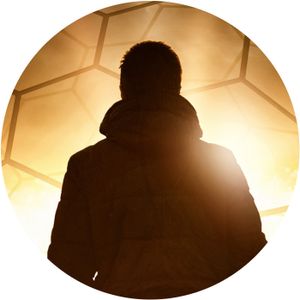They said the planet would be lifeless until we released the terraform probes. They’d use our inertia to reach our new home two years ahead of us. We’d settle into orbit for another couple of generations, and when the planet surface was ready, we’d finally settle humans on Zan-wu.
The journey started over a millennium ago, the four arks leaving Earth over a three-month period. We remained in contact with Bahu, Shuque and Kinlong — each, like us, named for their destination — until we left our galaxy. By then, we were beyond the range of our old home, leaving those who had remained to their slow, painful fate.
Our history, as told in our fragmented records, is one of turbulence, anarchy and chaos, yet we’ve always been working for the future. Our scientists improved our ark no end, although the holy grail of FTL always remained out of reach. And as we neared our destination a sombre peace settled.
I’d been trained from birth, destined to join the initial settlers. I studied hard, working my way up from junior technician to senior analyst, earning the respect of my peers and the envy of many. And I was there when we discovered the shocking truth.
The planet was already alive.
The atmosphere was breathable, and weather patterns flowed across the sky. The polar regions were ice-encased, and there was much water on the planet. On the land we detected countless varieties of plants and animals. Birds flew through the air, sea creatures swam in the depths. We spotted insects and micro-organisms.
And there was intelligence.
We discovered artificial structures, some in small groups, others in masses that covered many kilometres. Lines that were clearly transport systems connected these groups. Artificial creations passed over the water, and craft flew through the air.
We prepared the landing craft in solemn silence. My stomach fluttered with both excitement and fear as we detached from the ark and fell to the planet’s surface. We flared into the atmosphere and landed in an area a few days’ travel from the nearest group of buildings.
Our plan was to observe, but in turn we were being watched. On the fourth day, when we took our first tentative steps beyond our craft, the locals appeared.
They were humanoid, perhaps a half-metre shorter than us. Their skin colouration varied, as did their hair coverings. They wore clothing that seemed to mould itself to their forms, even around their feet. They wore belts from which hung unfamiliar objects that could have been weapons, and while a few drew these to hold in a defensive manner, their attitude did not appear aggressive. For that we were thankful, and in return we approached them in peace.
They spoke in a language that almost seemed familiar, and we turned to our team’s linguist. He recited greetings in various languages, many of them archaic even to our ears.
The locals formed a huddle, and seemed to communicate without sound. Then one of them stepped forward.
I think of her as female, more for her manners than any physical characteristics. Her wide mouth curled into a soft smile as she spoke in stilted Standard.
“Welcome, travellers. It has been time long.”
With that, we were accepted.
They escorted us to a building made of cloth, one our sensors had not detected — possibly because it was a temporary structure, despite its strong construction. Within were platforms that moulded to our bodies when our hosts bade us sit, far superior to our recliners. They gave us food and drink that were filling and pleasant.
We talked. Or, rather, the female local conversed with our linguist. She asked about our craft, about our technology.
His answers were met with sage nods, as if this was what she expected from us. She said they had once used similar processes, but had since progressed. She spoke of electron parity fusion, and quark-splits — at least, I think she did. It was hard to follow.
Then she asked if we had kept to the old Earth calendar.
Our linguist had only mentioned Earth in passing. I became more alert.
She asked how many years we had been journeying, and when he quoted the exact number, she nodded again, said that made sense, considering the distance and our technological advances.
And all this time, I felt that we were being treated as children — bright and well-mannered, but still children.
“We have much show to you,” she said. “But with caution always. Monumental, this time of cousins reunited.”
Unease stirred in my mind. I leaned in close to our linguist. “Ask if they have FTL.”
He did, explaining the concept until she smiled and laughed.
“For years eight hundred more. A breakthrough as dying home, brave cousins remaining. Then, escape, a life new.”
Cousins. That word hit me hard, and in a flash I understood.
We’d never broken the speed of light because the experts in that field had remained on Earth. They’d claimed to be close, called our escape strategy premature. When we last heard from them, they’d made no progress.
But their struggles didn’t stop when we were out of range.
I called our team together, and spoke my thoughts. Eyes widened in surprise, and then they nodded as they accepted the truth.
I looked to our new friends, our cousins. The gravity here was stronger than on Earth, enough to account for shorter, stouter forms after eight hundred years of evolution. No doubt over our thousand-year journey we had changed from our ancestors too.
She smiled at us, the gesture so familiar, so full of humanity.
Our mission had always been survival amongst the stars, to leave a dying planet and find a new home. And we’d done that, only it had happened years before we’d expected.
We’d taken the long way round. But now we’d come home.
